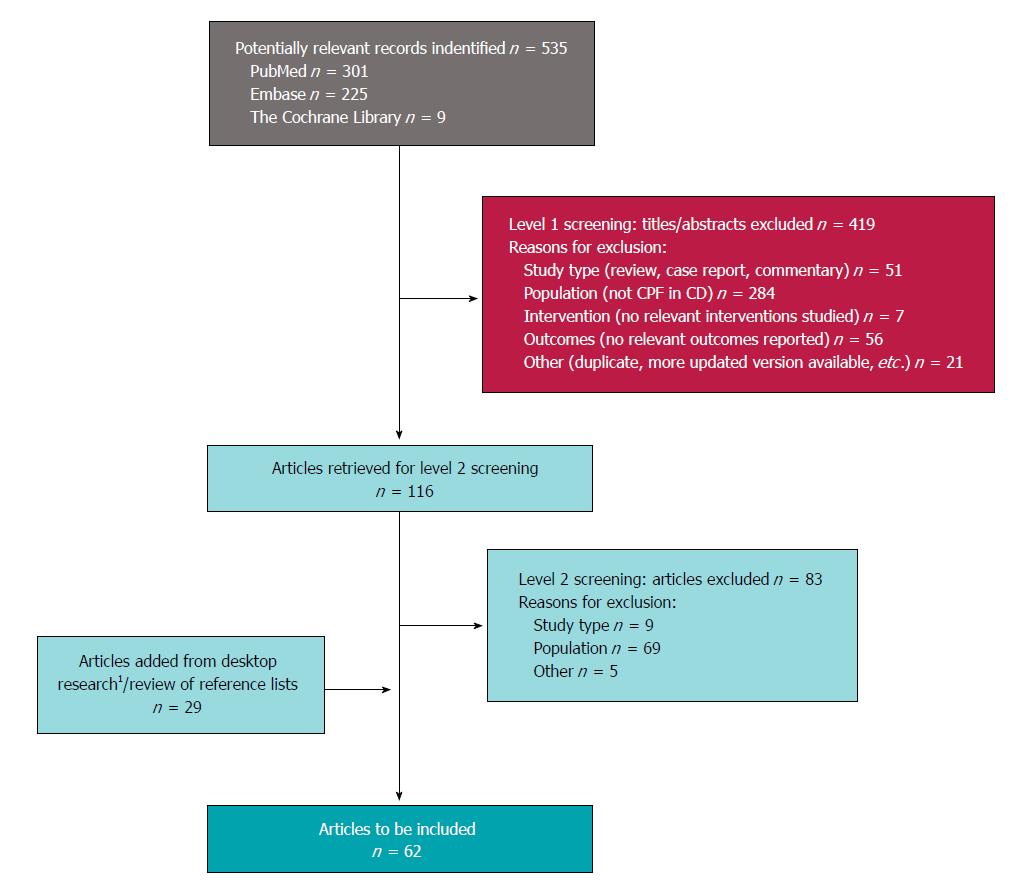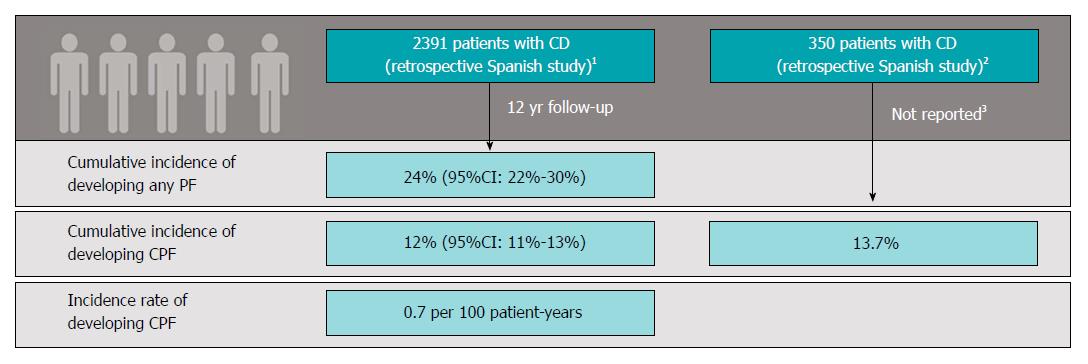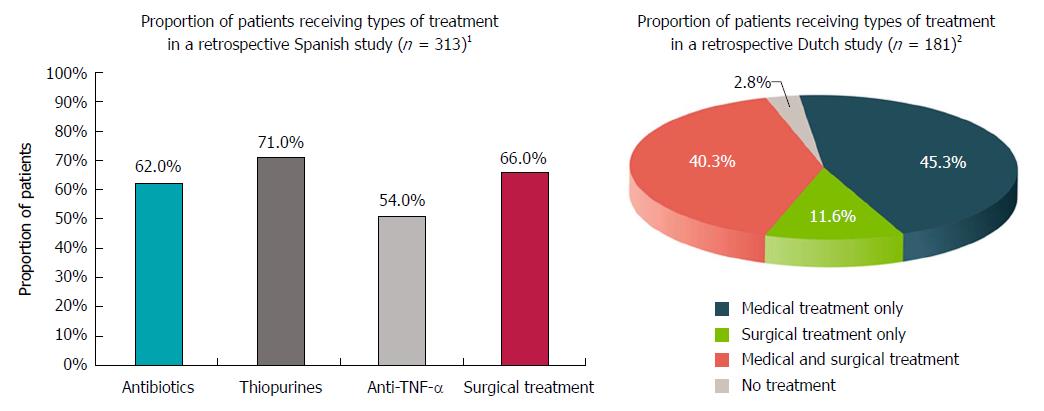Copyright
©The Author(s) 2018.
World J Gastroenterol. Nov 14, 2018; 24(42): 4821-4834
Published online Nov 14, 2018. doi: 10.3748/wjg.v24.i42.4821
Published online Nov 14, 2018. doi: 10.3748/wjg.v24.i42.4821
Figure 1 Preferred Reporting Items for Systematic Reviews and Meta-Analyses diagram.
1Includes 12 studies identified via search of congress abstracts, and not published elsewhere. CD: Crohn’s disease; CPF: Complex perianal fistula; PRISMA: Preferred Reporting Items for Systematic Reviews and Meta-Analyses.
Figure 2 Epidemiology of complex perianal fistula in Crohn’s disease.
1Chaparro et al[8] published in 2011. Definition of complex perianal fistulas (CPF): A fistula meeting any of the following criteria: High location (high intersphincteric, high transsphincteric, extrasphincteric, or suprasphincteric), multiple external openings, perianal abscess, anal stenosis, or proctitis. Retrospective multicentre study conducted in 11 hospitals in Madrid, Spain (study period was not reported); 2Morete et al[9] published in 2013. Definition of CPF not given. Retrospective single-centre study (Ferrol, Spain) with 15 yr of follow-up; 3Analysis of patients followed up at reporting institution over 15 yr; mean per-patient follow-up not noted. Note: Both studies were presented as conference abstracts only and were not published in a peer-reviewed journal. Thus, data are limited and difficult to assess for robustness. CD: Crohn’s disease; CI: Confidence interval; CPF: Complex perianal fistula; PF: Perianal fistula.
Figure 3 Treatment choices.
1Retrospective multicentre study (study period or median follow-up time were not reported) enrolling patients with Crohn’s disease (CD) and PFs; 80% had complex perianal fistulas (CPF). The graph presents treatment selection for patients with any fistula. Patients could have received multiple treatments (proportion of patients who received combination therapy was not reported). The most common surgical intervention was fistulotomy (37%), followed by placement of setons (32%)[18]. 2Retrospective single-centre study enrolling patients with CD and any perianal fistula [n = 232 patients, of which 181 (78%) had CPF]; patient identification: 1980-2000, follow-up through January 1, 2010; median follow-up was 10.0 yr (range, 0.5-37.5 yr). The graph presents treatment choices for 181 patients with CD and CPF. The most common type of surgery (alone or in combination with medical treatment) was faecal diversion (stoma; 63.6% of 94 patients with CPF who underwent surgery; 33.1% of all 181 patients with CPF), followed by colectomy (55.3% of patients with CPF who underwent surgery; 28.7% of all patients with CPF), fistulectomy (42.6% of patients with CPF who underwent surgery; 22.1% of all patients with CPF), and rectum amputation (proctectomy; 25.5% of patients with CPF who underwent surgery; 13.3% of all patients with CPF)[13].
Figure 4 Rates of treatment failure and relapse or recurrence among Crohn’s disease patients with complex perianal fistula1.
1For studies with mixed populations (i.e., patients with any fistula and those with complex fistula), only results for patients with Crohn’s disease and complex perianal fistulas were considered; 2Defined as lack of or inadequate response to therapy (i.e., lack of complete response or lack of healing response); 3Most studies (10 of 12) reported outcomes for surgical procedures that were considered major procedures in this review, ligation of intersphincteric fistula tract, advancement flap repair, mucosal advancement flap with injection of platelet-rich plasma into the fistula tract, myocutaneous flaps and proctocolectomy with permanent ileostomy, gracilis muscle transposition, over-the-scope-clip proctology, fistula tract transposition or standard surgical management (including both major and minor procedures)[34-36,42,48-50,53,54,66]. One study reported outcomes with permanent seton (minor procedure; other minor procedures reported in studies mentioned above included biologic fistula plug, and fibrin glue)[52]. One study did not specify the type of surgery[11]; 4Most (12 of 15) studies assessed surgical procedures that are considered minor procedures (seton drainage (most frequently), abscess drainage, fistulotomy, fibrin glue)[10,29,38-41,43,67-71]. Two studies assessed surgical procedures that are considered major procedures (mucosal advancement flap, resection, stoma, proctectomy)[37,51]. Surgery type was not defined in one study[72]; 5Defined as usual care used at each centre [standard medical care (excluding anti-tumour necrosis factors) and surgery in two studies, and standard medical care (including anti-tumour necrosis factor alpha agents) and surgery in two studies]. TNF-α: Tumour necrosis factor alpha.
- Citation: Panes J, Reinisch W, Rupniewska E, Khan S, Forns J, Khalid JM, Bojic D, Patel H. Burden and outcomes for complex perianal fistulas in Crohn’s disease: Systematic review. World J Gastroenterol 2018; 24(42): 4821-4834
- URL: https://www.wjgnet.com/1007-9327/full/v24/i42/4821.htm
- DOI: https://dx.doi.org/10.3748/wjg.v24.i42.4821












